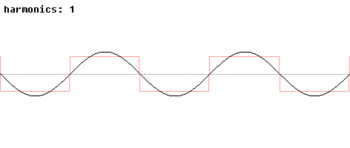Solution
This response is due to ringing artifacts from the interpolation filters necessary to perform the Delta-Sigma modulation. This usually appears as an overshoot and then a settling time, also described as rounding after an instantaneous change occurs, such as the rising or falling edge of a square wave.
An example of this response is shown below:
Mathematically, this can be described as
Gibbs Phenomenon, which is the result of an instantaneous change to a system with a finite number of samples. A pure sine wave has only a single fundamental frequency and no higher-order harmonics. A square wave has an infinite number of frequency components. A sine wave can be transformed into a square wave by adding harmonics to its fundamental. As such, an infinite number of harmonics will produce a perfect square wave. However, if the bandwidth of the system is limited, as is the case with all discrete devices, some harmonics will not be present in the signal; thus, distortion of the waveform occurs.
The use of harmonics to build a square wave is demonstrated in the figure below:

NI DSA devices are designed to generate and acquire dynamic signals such as those found in sound and vibration applications. This behavior is expected behavior for NIs DSA devices. On NI DSA devices the interpolation filters are necessary with Delta-Sigma converters, there is no way to disable them. This includes but isn't limited to: NI 4431, NI 4432, NI 4461, NI 4462, NI 4463, NI 4464, NI 4472, NI 4474, NI 4495, NI 4496, NI 4497, NI 4498 and NI 4499.
The NI 4480 and NI 4481 devices have significantly reduced ringing when used in Time Domain mode due to loose filtering; refer to the Time Domain Mode Acquisitions section of the PXIe-4480/4481 User Manual linked below for more information.
The use of NI Multifunction Data Acquisition (MIO DAQ) devices, such as the NI 63xx (formerly X Series) and NI 62xx (formerly M Series), will provide the best performance for DC applications. Alternatively, for purely digital applications, we recommend NI Digital I/O (DIO) products.